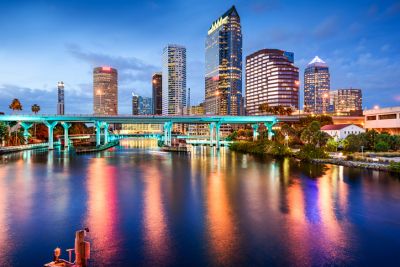 The Tampa Bay area is the second largest metropolitan area in Florida. Spanish explorers arrived in the area in the 16th century, but the area was inhabited by indigenous peoples for centuries before. Spain controlled the territory that would become Florida until 1821, when it was purchased by the U.S. About two decades later, Florida joined the Union but seceded to the Confederacy before the Civil War.
The Tampa Bay area is the second largest metropolitan area in Florida. Spanish explorers arrived in the area in the 16th century, but the area was inhabited by indigenous peoples for centuries before. Spain controlled the territory that would become Florida until 1821, when it was purchased by the U.S. About two decades later, Florida joined the Union but seceded to the Confederacy before the Civil War.
Following the war, Tampa’s population was decimated by several epidemics of yellow fever, carried by mosquitoes that lived in the swampland. The fort that had been established at Tampa Bay was decommissioned. At one point, the residents of the town abolished the city government. Population of the community dropped below 1,000 people in 1870.
In the mid-1880s, the economy changed. Phosphate was discovered in the area. A railroad was built to connect Tampa to the nation. Vicente Martinez Ybor brought the cigar industry to Tampa. These three things made Tampa into a boomtown. By 1900, it was one of the largest cities in Florida.
Tampa’s biggest religious claim to fame might be when Billy Graham preached his first sermon in a local church as a student at the Florida Bible Institute, which is now Trinity College of Florida. A plaque in the Billy Graham Memorial Park commemorates the spot where he went to practice his sermons in front of the birds and wildlife that lived in the region.
Today, Tampa has a broad religious community that represents several major world religions. Let’s take a look.
St. Mary Our Lady of Grace Catholic Church, St. Petersburg
This beautiful Byzantine building was styled after a church in Rome. Construction began in 1929 even though the congregation celebrated its first mass in 1892. The building is octagonal with a clay tile roof. Presently, it’s administrated by the Franciscan Friars. Make sure to see the stone carving over the main entrance, which depicts the Magi paying their respects to Christ on his birth.
Sacred Heart Catholic Church, Tampa
This stunning Romanesque Revival building was dedicated in 1905. It features a 135-foot dome, 70 stained-glass windows made in Germany and solid oak pews. It’s one of the oldest churches in the community, but it struggled with the same problems that Tampa had. The parish lost three of its pastors within a year when a yellow fever epidemic ravaged the population. The diocese lost over one-fourth of its priests during the same period. There were no pastors to serve the Tampa parish. When Tampa began to thrive again, so did the church.
St. Nicholas Greek Orthodox Cathedral, Tarpon Springs
This domed church is a stunning example of Neo-Byzantine architecture. The Greek marble altar originally was part of the Greek exhibit at the 1939 New York World’s Fair before being gifted to the church. The church also houses three chandeliers from Czechoslovakia.
St. James House of Prayer Episcopal Church, Tampa
In 1997, two congregations merged to form a new congregation, but the history of the building dates to 1895. St. James Episcopal Church served predominantly the Bahamians and Cubans who relocated to Tampa because of the cigar industry. The Episcopal House of Prayer was founded in 1907. Their congregation built the current building, which is listed on the National Register of Historic Places. It’s built in the Late Gothic Revival style.
The exterior walls are flint rock. Although the rock was collected locally, the ships that came into Tampa discarded the ballast from their hulls. This rock makes up the stunning stonework from all around the world.
St. James lost its building in the 1990s. The congregation of the House of Prayer was declining. The two congregations came together to preserve their heritage. They are still very active in the community.